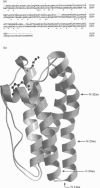Abstract
Ciliary neurotrophic factor (CNTF) promotes survival in vitro and in vivo of several neuronal cell types including sensory and motor neurons. The primary structure of CNTF suggests it to be a cytosolic protein with strong similarity to the alpha-helical cytokine family which is characterized by a bundle of four anti-parallel helices. CNTF exerts its activity via complexation with CNTF receptor (CNTF-R). This complex consists of a CNTF-binding protein (CNTF-R) and two proteins important for signal transduction [gp130 and leukaemia inhibitory factor receptor (LIF-R)]. We have shortened the cDNA coding for CNTF at both the 5' and the 3' end and expressed the truncated proteins in bacteria. Biological activities of the protein preparations were determined by their ability to induce proliferation of BAF/3 cells that were stably transfected with CNTF-R, gp130 and LIF-R cDNAs. CNTF proteins with 14 amino acid residues removed from the N-terminus were biologically active whereas the removal of 23 amino acids resulted in an inactive protein. In addition, 18 amino acid residues could be removed from the C-terminus of the CNTF protein without apparent loss of bioactivity, but further truncation at the C-terminus yielded biologically inactive proteins. The introduction of two point mutations into the CNTF protein at a site that presumably interacts with one of the two signal-transducing proteins resulted in a CNTF mutant with no measurable bioactivity. In addition, a model of the three-dimensional structure of human CNTF was constructed using the recently established structural co-ordinates of the related cytokine, granulocyte colony-stimulating factor. CD spectra of CNTF together with our mutational analysis and our three-dimensional model fully support the view that CNTF belongs to the family of alpha-helical cytokines. It is expected that our results will facilitate the rational design of CNTF mutants with agonistic or antagonistic properties.
Full text
PDF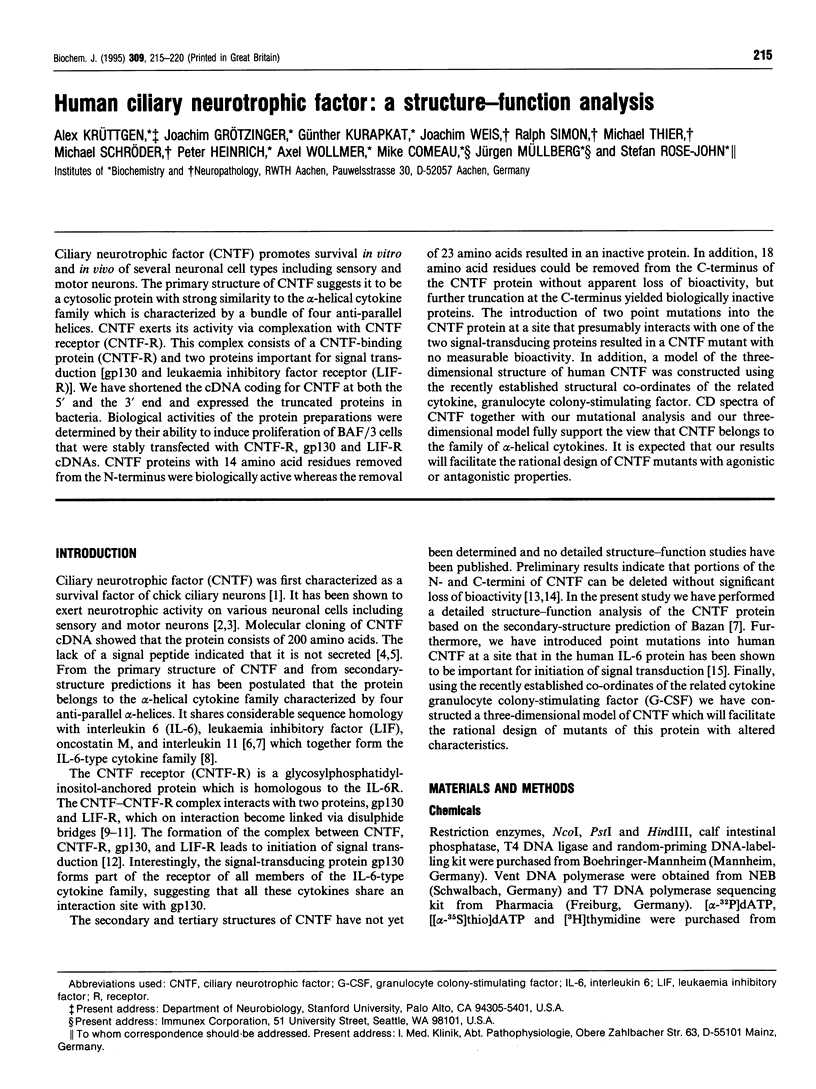
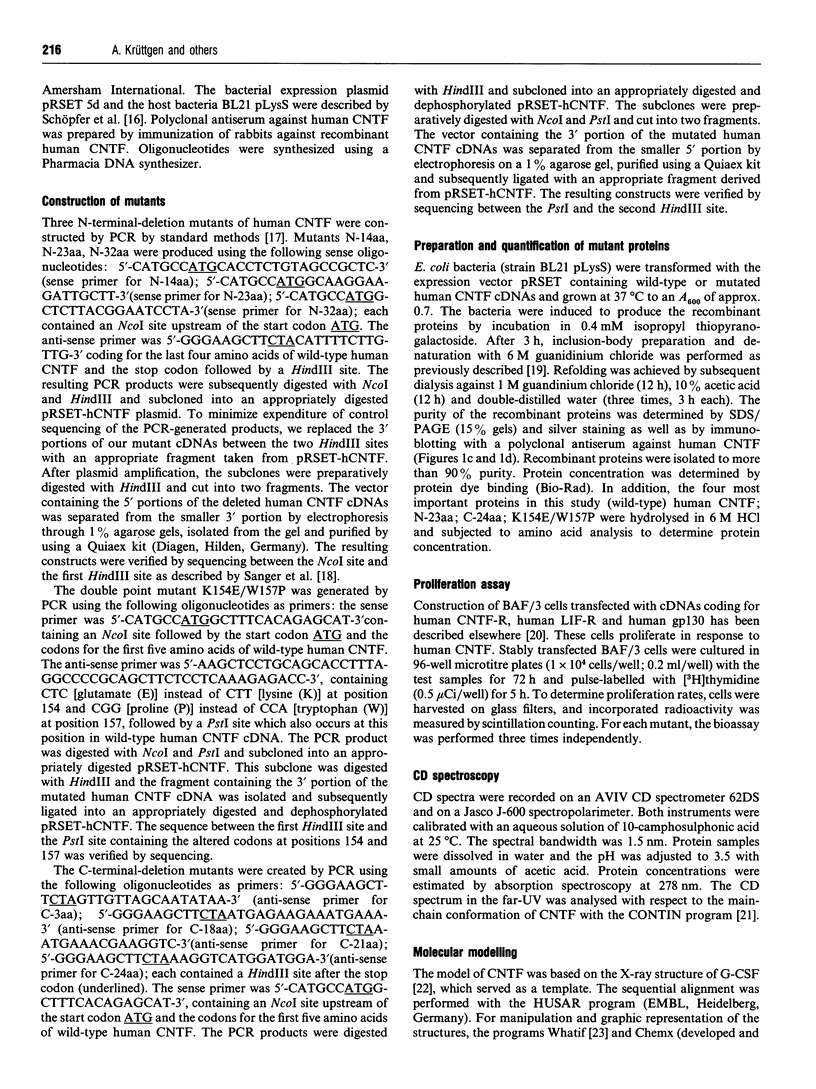

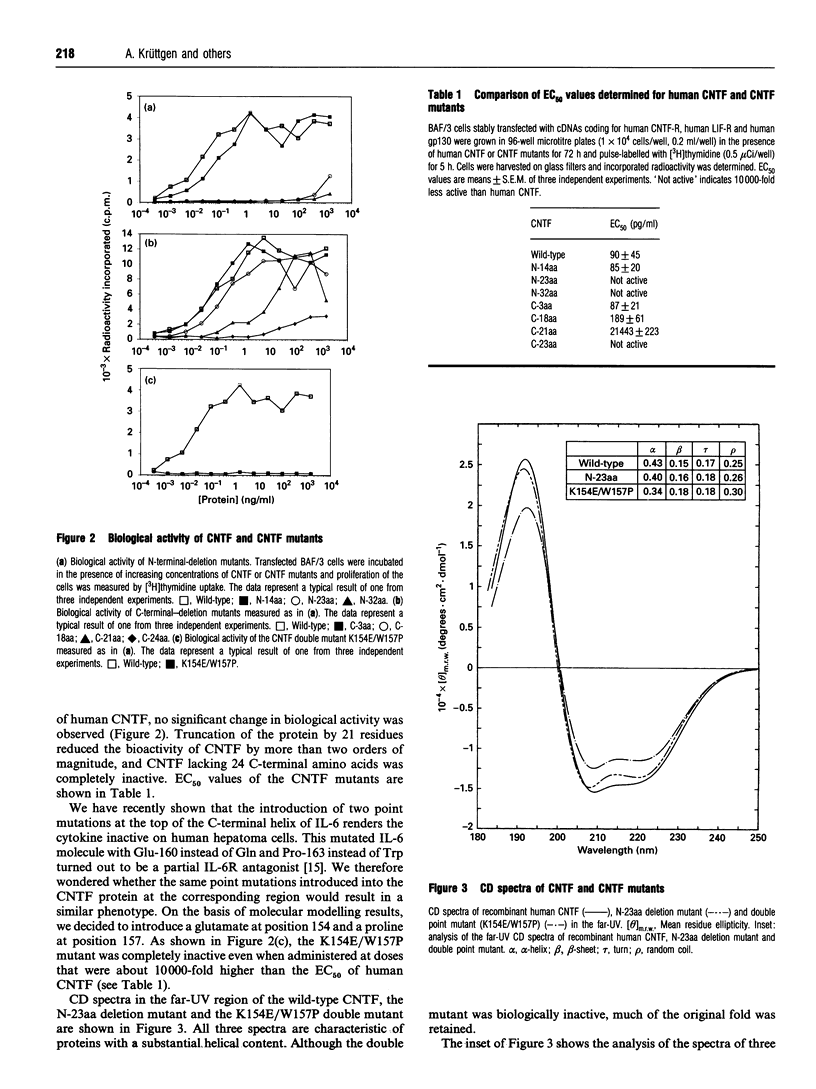
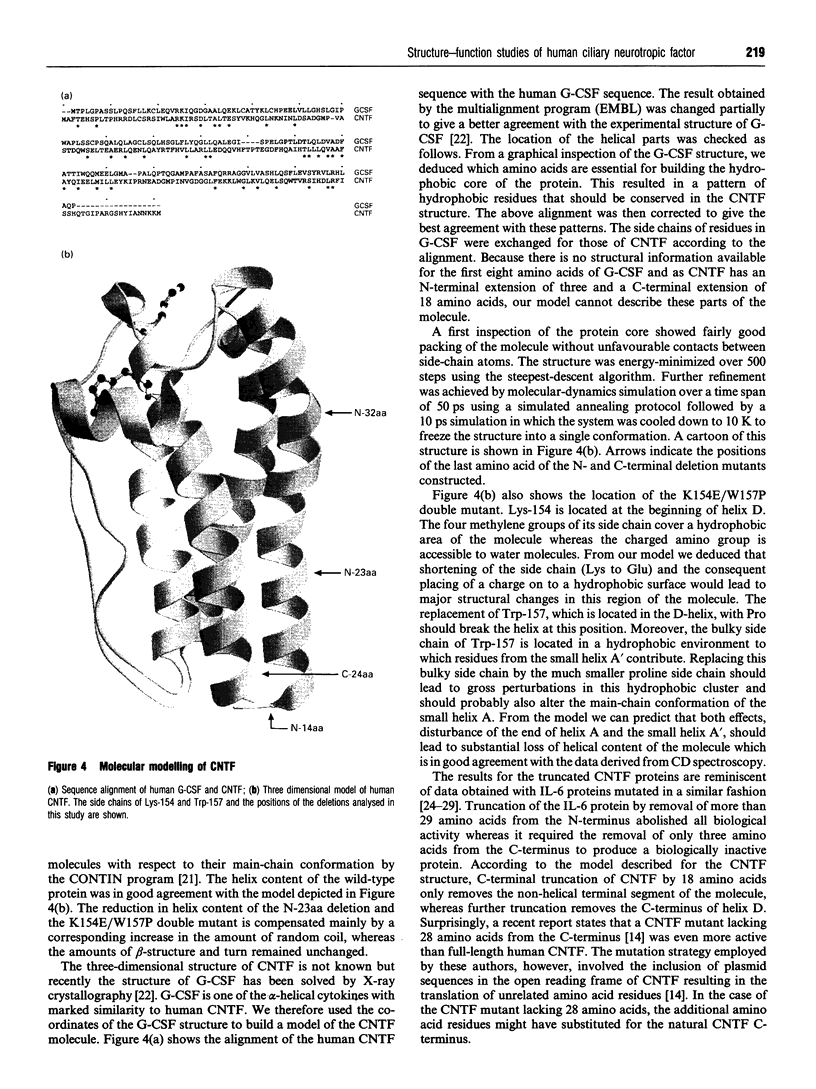
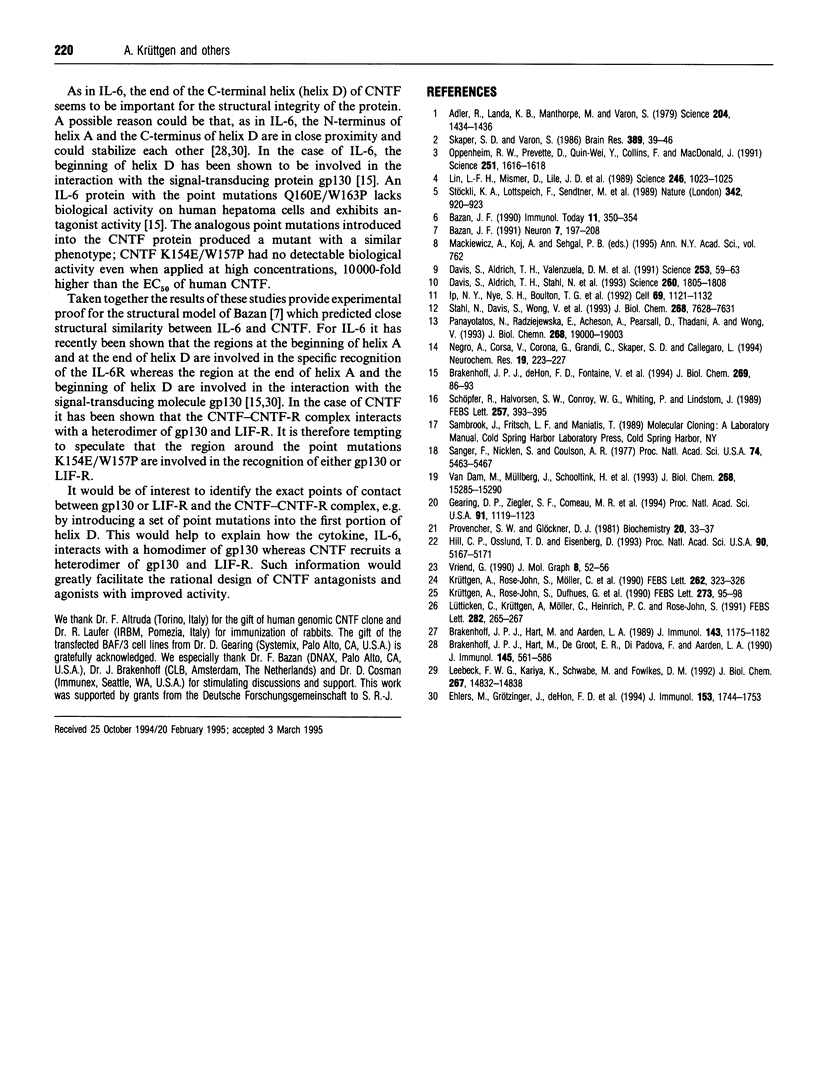
Images in this article
Selected References
These references are in PubMed. This may not be the complete list of references from this article.
- Adler R., Landa K. B., Manthorpe M., Varon S. Cholinergic neuronotrophic factors: intraocular distribution of trophic activity for ciliary neurons. Science. 1979 Jun 29;204(4400):1434–1436. doi: 10.1126/science.451576. [DOI] [PubMed] [Google Scholar]
- Bazan J. F. Haemopoietic receptors and helical cytokines. Immunol Today. 1990 Oct;11(10):350–354. doi: 10.1016/0167-5699(90)90139-z. [DOI] [PubMed] [Google Scholar]
- Bazan J. F. Neuropoietic cytokines in the hematopoietic fold. Neuron. 1991 Aug;7(2):197–208. doi: 10.1016/0896-6273(91)90258-2. [DOI] [PubMed] [Google Scholar]
- Brakenhoff J. P., Hart M., Aarden L. A. Analysis of human IL-6 mutants expressed in Escherichia coli. Biologic activities are not affected by deletion of amino acids 1-28. J Immunol. 1989 Aug 15;143(4):1175–1182. [PubMed] [Google Scholar]
- Brakenhoff J. P., Hart M., De Groot E. R., Di Padova F., Aarden L. A. Structure-function analysis of human IL-6. Epitope mapping of neutralizing monoclonal antibodies with amino- and carboxyl-terminal deletion mutants. J Immunol. 1990 Jul 15;145(2):561–568. [PubMed] [Google Scholar]
- Brakenhoff J. P., de Hon F. D., Fontaine V., ten Boekel E., Schooltink H., Rose-John S., Heinrich P. C., Content J., Aarden L. A. Development of a human interleukin-6 receptor antagonist. J Biol Chem. 1994 Jan 7;269(1):86–93. [PubMed] [Google Scholar]
- Davis S., Aldrich T. H., Stahl N., Pan L., Taga T., Kishimoto T., Ip N. Y., Yancopoulos G. D. LIFR beta and gp130 as heterodimerizing signal transducers of the tripartite CNTF receptor. Science. 1993 Jun 18;260(5115):1805–1808. doi: 10.1126/science.8390097. [DOI] [PubMed] [Google Scholar]
- Davis S., Aldrich T. H., Valenzuela D. M., Wong V. V., Furth M. E., Squinto S. P., Yancopoulos G. D. The receptor for ciliary neurotrophic factor. Science. 1991 Jul 5;253(5015):59–63. doi: 10.1126/science.1648265. [DOI] [PubMed] [Google Scholar]
- Ehlers M., Grötzinger J., deHon F. D., Müllberg J., Brakenhoff J. P., Liu J., Wollmer A., Rose-John S. Identification of two novel regions of human IL-6 responsible for receptor binding and signal transduction. J Immunol. 1994 Aug 15;153(4):1744–1753. [PubMed] [Google Scholar]
- Gearing D. P., Ziegler S. F., Comeau M. R., Friend D., Thoma B., Cosman D., Park L., Mosley B. Proliferative responses and binding properties of hematopoietic cells transfected with low-affinity receptors for leukemia inhibitory factor, oncostatin M, and ciliary neurotrophic factor. Proc Natl Acad Sci U S A. 1994 Feb 1;91(3):1119–1123. doi: 10.1073/pnas.91.3.1119. [DOI] [PMC free article] [PubMed] [Google Scholar]
- Ip N. Y., Nye S. H., Boulton T. G., Davis S., Taga T., Li Y., Birren S. J., Yasukawa K., Kishimoto T., Anderson D. J. CNTF and LIF act on neuronal cells via shared signaling pathways that involve the IL-6 signal transducing receptor component gp130. Cell. 1992 Jun 26;69(7):1121–1132. doi: 10.1016/0092-8674(92)90634-o. [DOI] [PubMed] [Google Scholar]
- Krüttgen A., Rose-John S., Dufhues G., Bender S., Lütticken C., Freyer P., Heinrich P. C. The three carboxy-terminal amino acids of human interleukin-6 are essential for its biological activity. FEBS Lett. 1990 Oct 29;273(1-2):95–98. doi: 10.1016/0014-5793(90)81059-w. [DOI] [PubMed] [Google Scholar]
- Krüttgen A., Rose-John S., Möller C., Wroblowski B., Wollmer A., Müllberg J., Hirano T., Kishimoto T., Heinrich P. C. Structure-function analysis of human interleukin-6. Evidence for the involvement of the carboxy-terminus in function. FEBS Lett. 1990 Mar 26;262(2):323–326. doi: 10.1016/0014-5793(90)80219-9. [DOI] [PubMed] [Google Scholar]
- Leebeek F. W., Kariya K., Schwabe M., Fowlkes D. M. Identification of a receptor binding site in the carboxyl terminus of human interleukin-6. J Biol Chem. 1992 Jul 25;267(21):14832–14838. [PubMed] [Google Scholar]
- Lin L. F., Mismer D., Lile J. D., Armes L. G., Butler E. T., 3rd, Vannice J. L., Collins F. Purification, cloning, and expression of ciliary neurotrophic factor (CNTF). Science. 1989 Nov 24;246(4933):1023–1025. doi: 10.1126/science.2587985. [DOI] [PubMed] [Google Scholar]
- Lütticken C., Krüttgen A., Möller C., Heinrich P. C., Rose-John S. Evidence for the importance of a positive charge and an alpha-helical structure of the C-terminus for biological activity of human IL-6. FEBS Lett. 1991 May 6;282(2):265–267. doi: 10.1016/0014-5793(91)80491-k. [DOI] [PubMed] [Google Scholar]
- Negro A., Corsa V., Corona G., Grandi C., Skaper S. D., Callegaro L. Structure-function studies of human ciliary neurotrophic factor. Neurochem Res. 1994 Feb;19(2):223–227. doi: 10.1007/BF00966820. [DOI] [PubMed] [Google Scholar]
- Oppenheim R. W., Prevette D., Yin Q. W., Collins F., MacDonald J. Control of embryonic motoneuron survival in vivo by ciliary neurotrophic factor. Science. 1991 Mar 29;251(5001):1616–1618. doi: 10.1126/science.2011743. [DOI] [PubMed] [Google Scholar]
- Panayotatos N., Radziejewska E., Acheson A., Pearsall D., Thadani A., Wong V. Exchange of a single amino acid interconverts the specific activity and gel mobility of human and rat ciliary neurotrophic factors. J Biol Chem. 1993 Sep 5;268(25):19000–19003. [PubMed] [Google Scholar]
- Provencher S. W., Glöckner J. Estimation of globular protein secondary structure from circular dichroism. Biochemistry. 1981 Jan 6;20(1):33–37. doi: 10.1021/bi00504a006. [DOI] [PubMed] [Google Scholar]
- Sanger F., Nicklen S., Coulson A. R. DNA sequencing with chain-terminating inhibitors. Proc Natl Acad Sci U S A. 1977 Dec;74(12):5463–5467. doi: 10.1073/pnas.74.12.5463. [DOI] [PMC free article] [PubMed] [Google Scholar]
- Schoepfer R., Halvorsen S. W., Conroy W. G., Whiting P., Lindstrom J. Antisera against an acetylcholine receptor alpha 3 fusion protein bind to ganglionic but not to brain nicotinic acetylcholine receptors. FEBS Lett. 1989 Nov 6;257(2):393–399. doi: 10.1016/0014-5793(89)81580-7. [DOI] [PubMed] [Google Scholar]
- Skaper S. D., Varon S. Age-dependent control of dorsal root ganglion neuron survival by macromolecular and low-molecular-weight trophic agents and substratum-bound laminins. Brain Res. 1986 Jan;389(1-2):39–46. doi: 10.1016/0165-3806(86)90171-9. [DOI] [PubMed] [Google Scholar]
- Stahl N., Davis S., Wong V., Taga T., Kishimoto T., Ip N. Y., Yancopoulos G. D. Cross-linking identifies leukemia inhibitory factor-binding protein as a ciliary neurotrophic factor receptor component. J Biol Chem. 1993 Apr 15;268(11):7628–7631. [PubMed] [Google Scholar]
- Stöckli K. A., Lottspeich F., Sendtner M., Masiakowski P., Carroll P., Götz R., Lindholm D., Thoenen H. Molecular cloning, expression and regional distribution of rat ciliary neurotrophic factor. Nature. 1989 Dec 21;342(6252):920–923. doi: 10.1038/342920a0. [DOI] [PubMed] [Google Scholar]
- Vriend G. WHAT IF: a molecular modeling and drug design program. J Mol Graph. 1990 Mar;8(1):52-6, 29. doi: 10.1016/0263-7855(90)80070-v. [DOI] [PubMed] [Google Scholar]
- van Dam M., Müllberg J., Schooltink H., Stoyan T., Brakenhoff J. P., Graeve L., Heinrich P. C., Rose-John S. Structure-function analysis of interleukin-6 utilizing human/murine chimeric molecules. Involvement of two separate domains in receptor binding. J Biol Chem. 1993 Jul 15;268(20):15285–15290. [PubMed] [Google Scholar]




